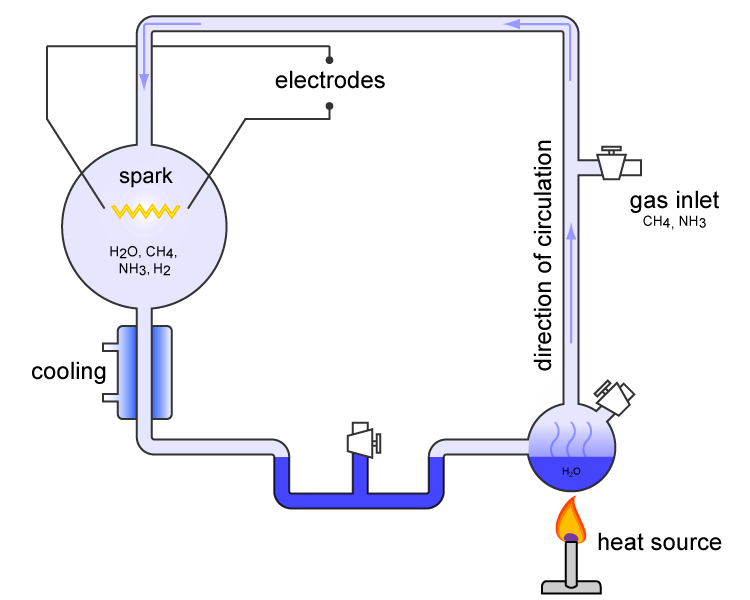BIO 101: Origin of Life (concluding part)
Introduction
In the previous post, we started the discussion on how life came into existence and how being able to provide answers to the question of the origin of life is important to the study of living organisms. We discussed the various theories and explanations that have been put forward by philosophers and scientists alike; ranging from the reasonable to the most absurd ones. In today's article, we will continue our discussion on the origin of life, but this time, we will be discussing the scientifically plausible and explainable origin of life hypothesis that has ever been put forward and which currently holds water among scientists - the chemosynthetic theory or primordial soup of origin of life.

Chemosynthetic origin
The chemosynthetic theory of the origin of life hypothesized that life arose from a chemical soup, also known as the primordial soup. The theory whose major proponent is Alexander Oparin hypothesized the primitive earth's atmosphere as being hot and dense with gases such as methane, water vapour, hydrogen, and ammonia due to high volcanic activities that are characteristic of the planet back then.
As well all know that evaporation causes cooling and cooling causes condensation. With time, the water vapour in the atmosphere started condensing and forming pools of water bodies on the still-hot surface of the earth. The availability of water caused some of the remaining gases present in the atmosphere to start dissolving gradually, the water pools eventually turning to a form of chemical soup. It was from this soup that Oparin opined that the first life was formed.
What happened after the formation of the chemical soup?
The dissolution of the primitive earth's atmospheric gases into the puddles of water formed on the earth's surface triggered a series of chemical reactions within the puddles. The reactions were catalyzed by the heat emanating from the earth's surface, the UV rays from the sun, as well as the occasional lightning/electrical discharge that was characteristic of the atmosphere back then. It is believed that these reactions led to the formation of important biomolecules of life such as amino acids, purines, pyrimidines, and simple carbohydrate molecules. But it does not stop there!
Activities continue within the chemical soup with several reactions pitching small similar molecules together to form bigger and more complex biomolecules of life. For example, the amino acids combined to form polypeptides and proteins, the purine and pyrimidine bases combined with sugars and phosphates to form nucleic acids, and the simple carbohydrates combined to form more complex ones.
Formation of coercervates
According to Oparin, the formation of larger and more complex biomolecules was followed by their aggregation to form a complex unit known as the coacervate droplet. The biomolecule aggregation was surrounded by a film of water in a membrane-like manner. At this point, the entire structure is still considered non-living until after continuous reactions within the coacervate led to the evolution of the first cell - the protocell. There are other hypotheses as to the origin of the protocell but the coacervate droplet hypothesis is more scientifically explainable and has been demonstrated in the laboratory as been capable of selectively absorbing substances from the surrounding water and adding such to their already existing structure.
Development of the first cell
Coercervate droplets kept on exchanging materials with their surrounding water and were thought not to be alive at this junction due to the absence of membrane, although they possessed the ability to increase in size as demonstrated in various laboratory experiments. source.
The droplets eventually gave rise to protocells and the first prokaryotic cell was hypothesized to have formed from these protocells. source The formation of self-replicating biomolecule led to the evolution of the first cell due to mutation. It is only logical that the first cells to be formed from the protocells were prokaryotic as well as heterotrophic due to the absence of membrane and the oxygen-less environment that was still one of the characteristics of the earth's atmosphere back then.
It was quite easy for the first cell formed to be heterotrophic because they can easily exchange materials with their surrounding in continuation of protocell-ic life. The necessary materials for the continuation of life were obtained from the surrounding, initially in abundance, but as life went on, these materials became limited. Consequently, the heterotrophic cells either die of starvation or find a way around getting what they need to continue living. In the process of finding an alternative, the first autotrophic cell (the cyanobacteria) evolved.
The autotrophic cells were able to survive using water, the air in the atmosphere, and with the help of the energy from the sun to manufacture their foods and get the necessary energy to sustain life. The entire process of manufacturing food is what is today known as photosynthesis. Through this process, the first trace of oxygen in the atmosphere emerged. The oxygen resulted from photosynthesis.
6CO2 + 6H2O + energy ---> C6H12O6 + 6O2
Hence, the evolution of autotrophic cells from the heterotrophic cells gave rise to an oxygenated environment. From the autotrophic cells, continuous evolution as a result of trying to adapt to the changing environment gave rise to more complex lives.
Why Chemosynthetic Theory holds water
As we said earlier, the chemosynthetic theory of the origin of life seems to hold the most water of all the theories that have been put forward to explain how life came about. The reason is not far fetched - some of the claims made by the theory were investigated in the laboratory and found to be true.
Specifically, the claim that components of the primitive atmosphere are capable of dissolving in the pool of water in the presence of lightning discharge and heat to give rise to the precursors of biomolecules of life were investigated in the laboratory by Stanley Miller and Harold Urey in 1953. They simulated the conditions that are characteristics of the primitive earth in the laboratory and were able to recover some of the precursors in the chemical soup formed from the experiment. source

Thanks for your contribution to the STEMsocial community. Feel free to join us on discord to get to know the rest of us!
Please consider supporting our funding proposal, approving our witness (@stem.witness) or delegating to the @stemsocial account (for some ROI).
Please consider using the STEMsocial app app and including @stemsocial as a beneficiary to get a stronger support.
Congratulations @ummar! You have completed the following achievement on the Hive blockchain and have been rewarded with new badge(s) :
You can view your badges on your board and compare yourself to others in the Ranking
If you no longer want to receive notifications, reply to this comment with the word
STOPDo not miss the last post from @hivebuzz: